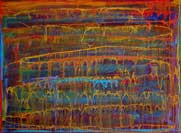PHOENIX ART MUSEUM
BOOK: REMINDERS OF INVISIBLE LIGHT
FELLOWSHIPS, AWARDS, GRANTS AND HONORS
ART NEWS 2002
ART NEWS 2006
SELECTED BIBLIOGRAPHY ON BETH AMES SWARTZ
ArtNews 2002:
Phoenix Art Museum
Phoenix
Vanier Galleries
Scottsdale |

Beth Ames Swartz
Visible Reminders, Listen, 2001
Acrylic on canvas, 36" x 48"
Vanier Galleries. |
Two concurrent exhibitions showcased the work of Phoenix painter Beth Ames Swartz, who has long believed art has a spiritual role in society. The Phoenix Art Museum hosted Swartz's first retrospective, spanning her four-decade career, while Vanier Galleries showcased 22 of her recent, enticing acrylic paintings. The museum's well-selected presentation provided a succinct view of Swartz's evolution, from early small-scale watercolors of the Western landscape to recent mixed-media abstractions pulsating with rhythmic pattern and dramatic color. The accompanying monograph, Reminders of Invisible Light: The Art of Beth Ames Swartz (copublished by Hudson Hills Press and the Phoenix Art Museum), handsomely augmented the works on view.
As the museum show revealed, Swartz experienced an important turning point in the 1970s, when she experimented with materials and the idea of ritual in the outdoors, exposing layers of paper to pigment, dirt, water, and flames. The charred remains exist as powerful evocations of the cycle of creation and destruction in art and life. She later incorporated specific imagery into her mixed-media works, depicting symbols relating to Buddhism, Christianity, and Native American belief systems. In the 1999 series "States of Change," for example, Swartz uses a dazzling gold-leaf grid as a recurring motif, a form derived from the iconography of Chinese healing practices.
In her most recent pieces, as shown at Vainer, Swartz deftly worked the surface of her supports, building up layers of color, gestural marks, and abstract patterns. In her "Visible Reminders" series, she used acrylic straight from the tube to scribble lines from Buddhist scriptures and her own poetry onto the raw canvas. Gooey layers of paint were then added, rendering most of these works indecipherable. She then overlayed the whole surface with a pattern of drips and streaks, using translucent pigment. Here, Swartz's approach is subtler than in her earlier symbol-laden works, reflecting a confidence in her materials and a willingness to let go of prescribed meanings.
John Villani
ARTnews / May 2002
A version of the Phoenix Art Museum exhibition is on view at the Herbert F. Johnson Museum of Art at Cornell University, Ithaca, New York, June 5 through July 14. |



